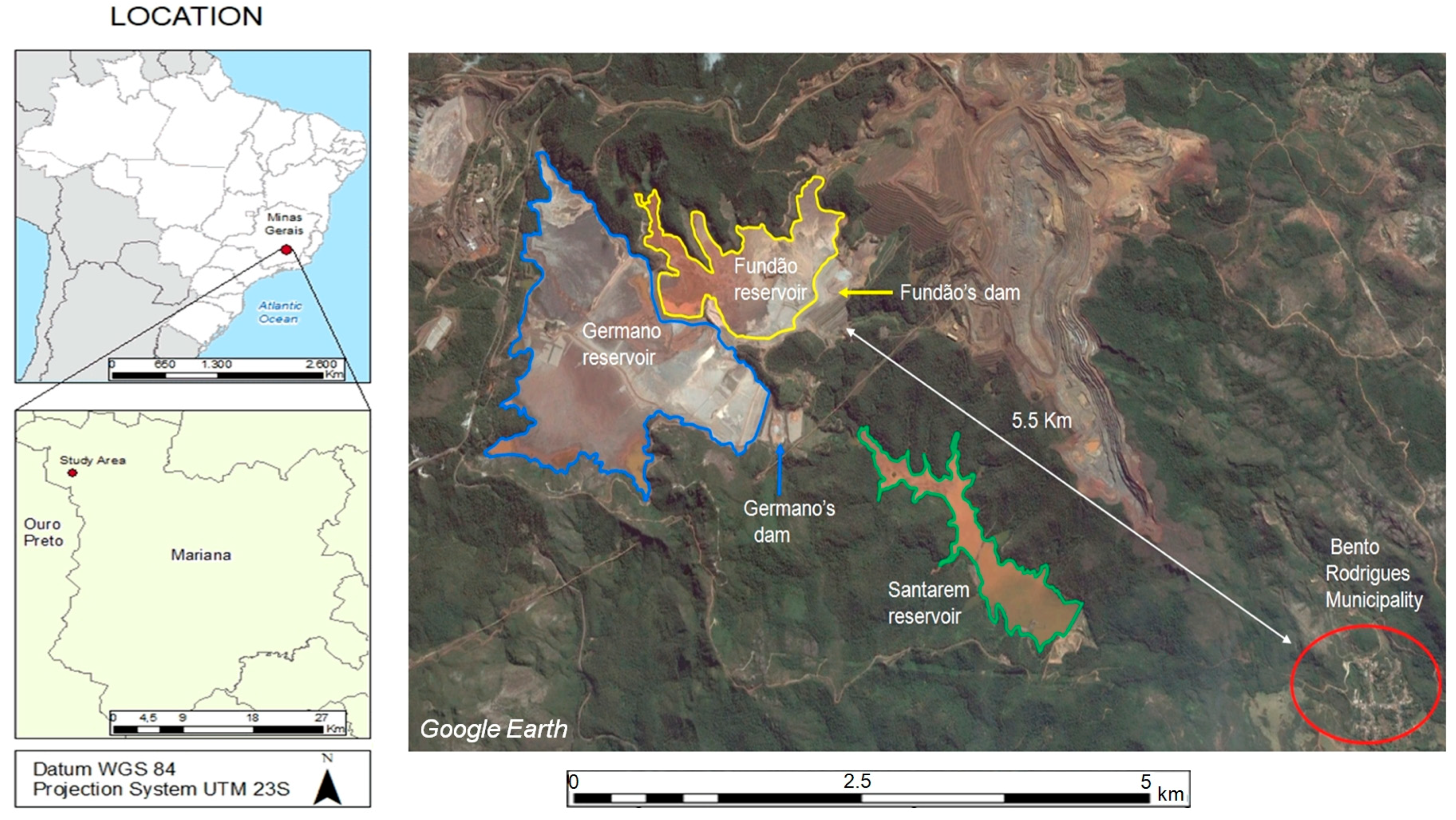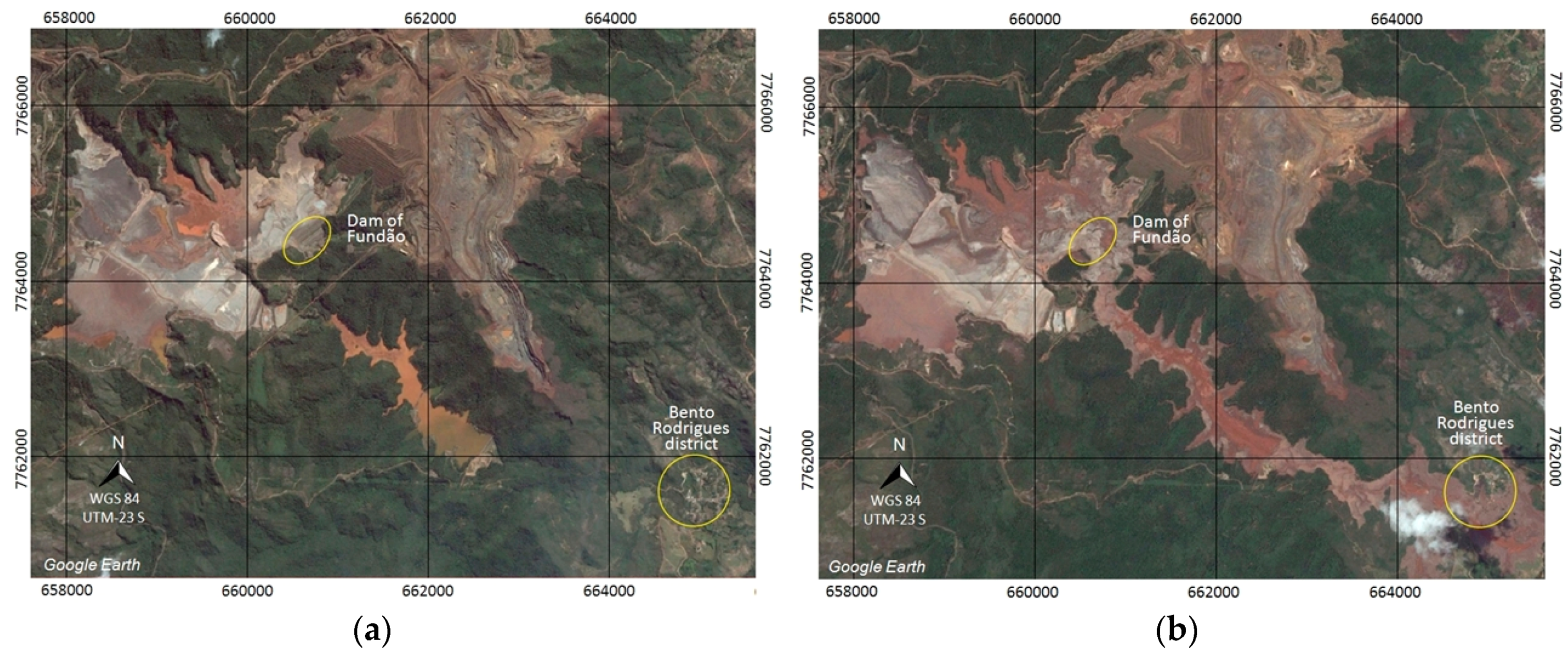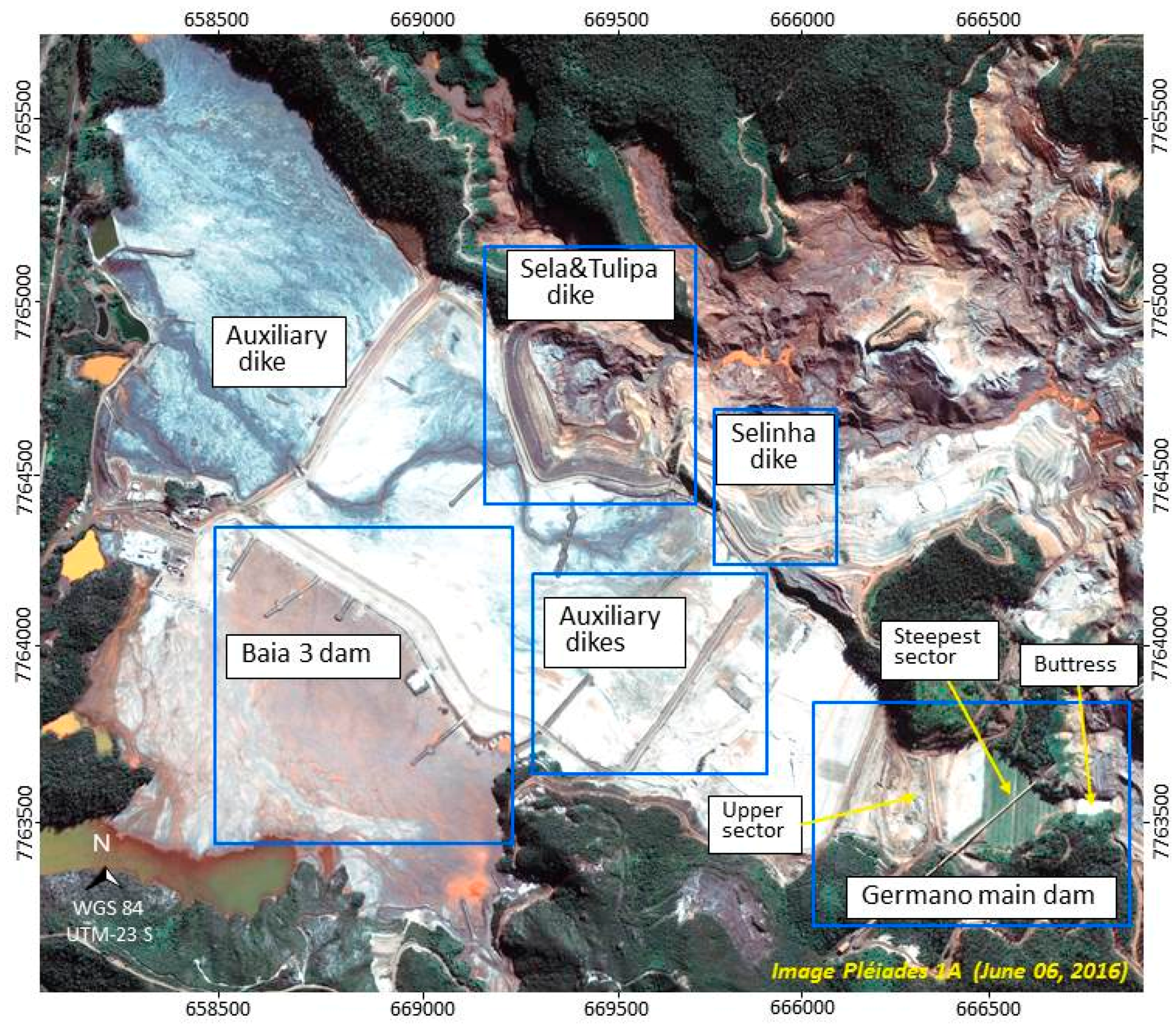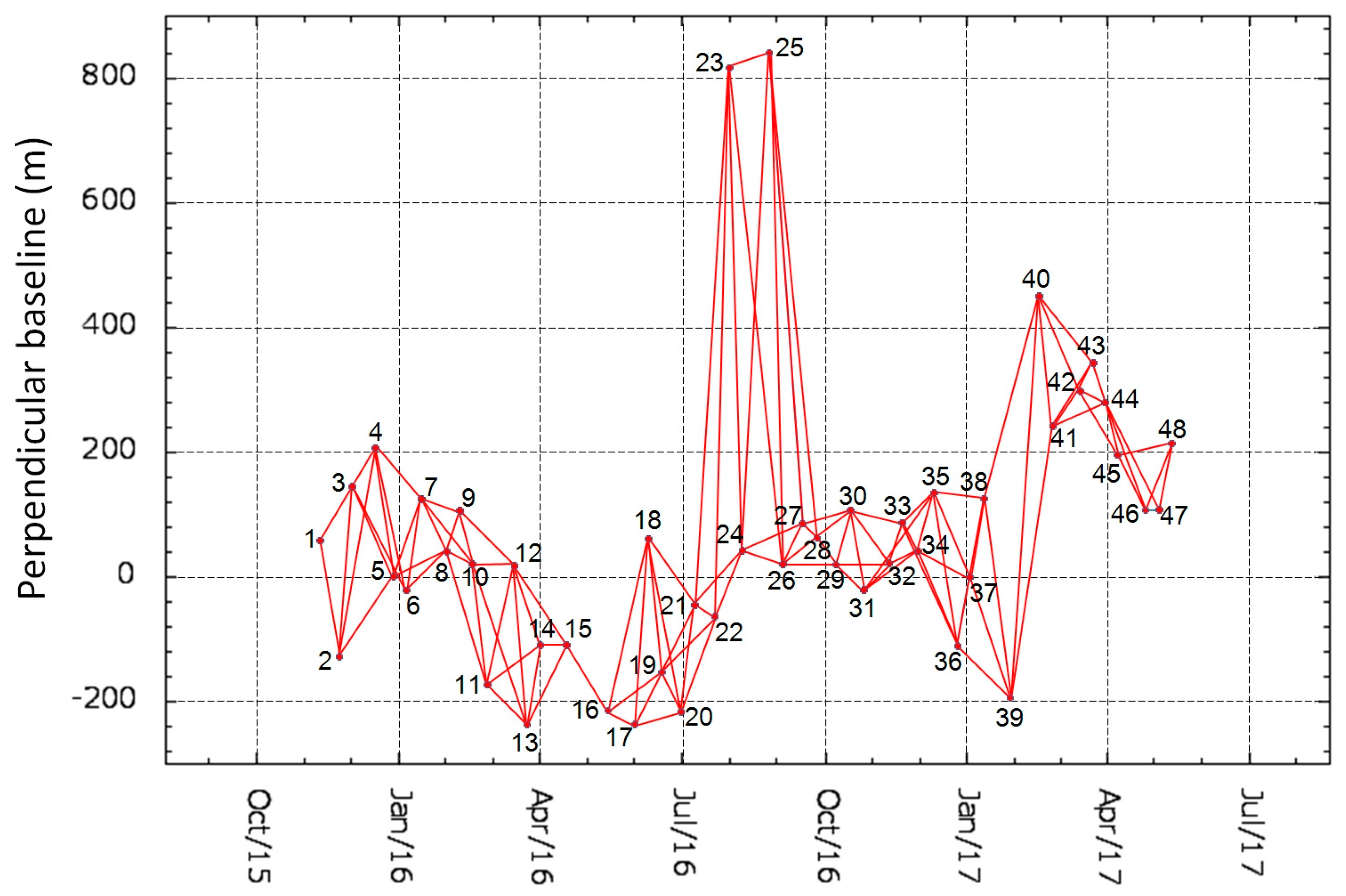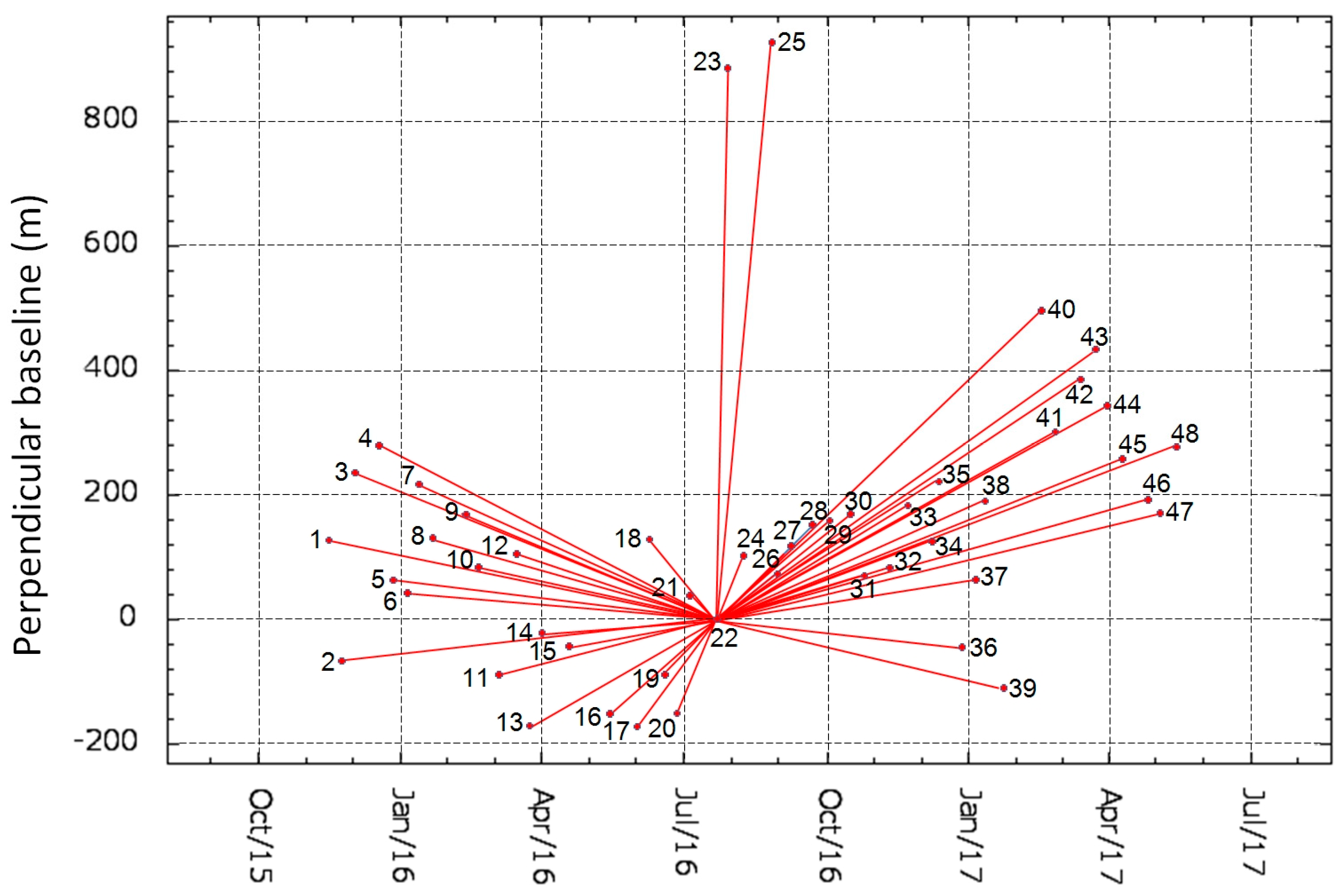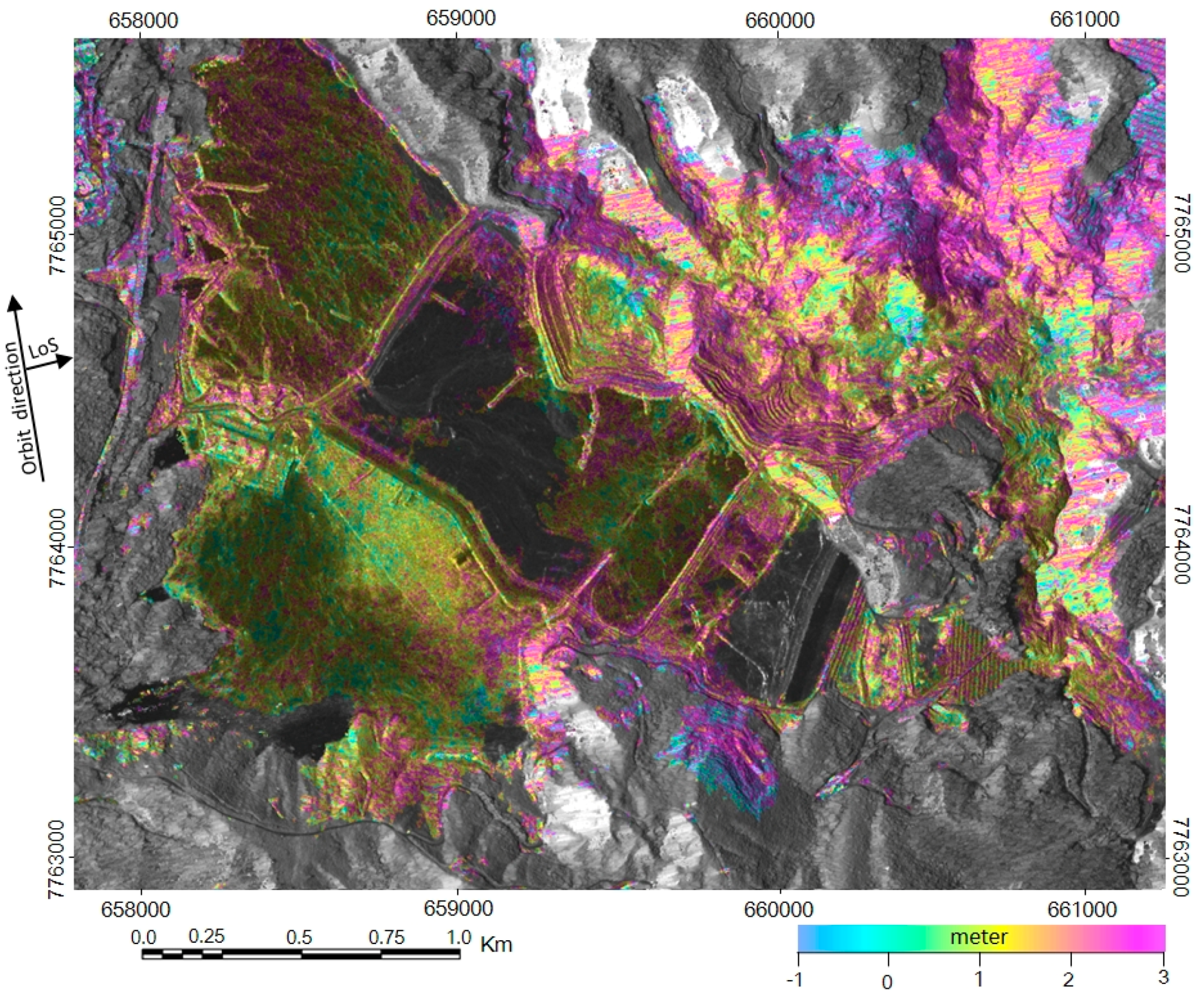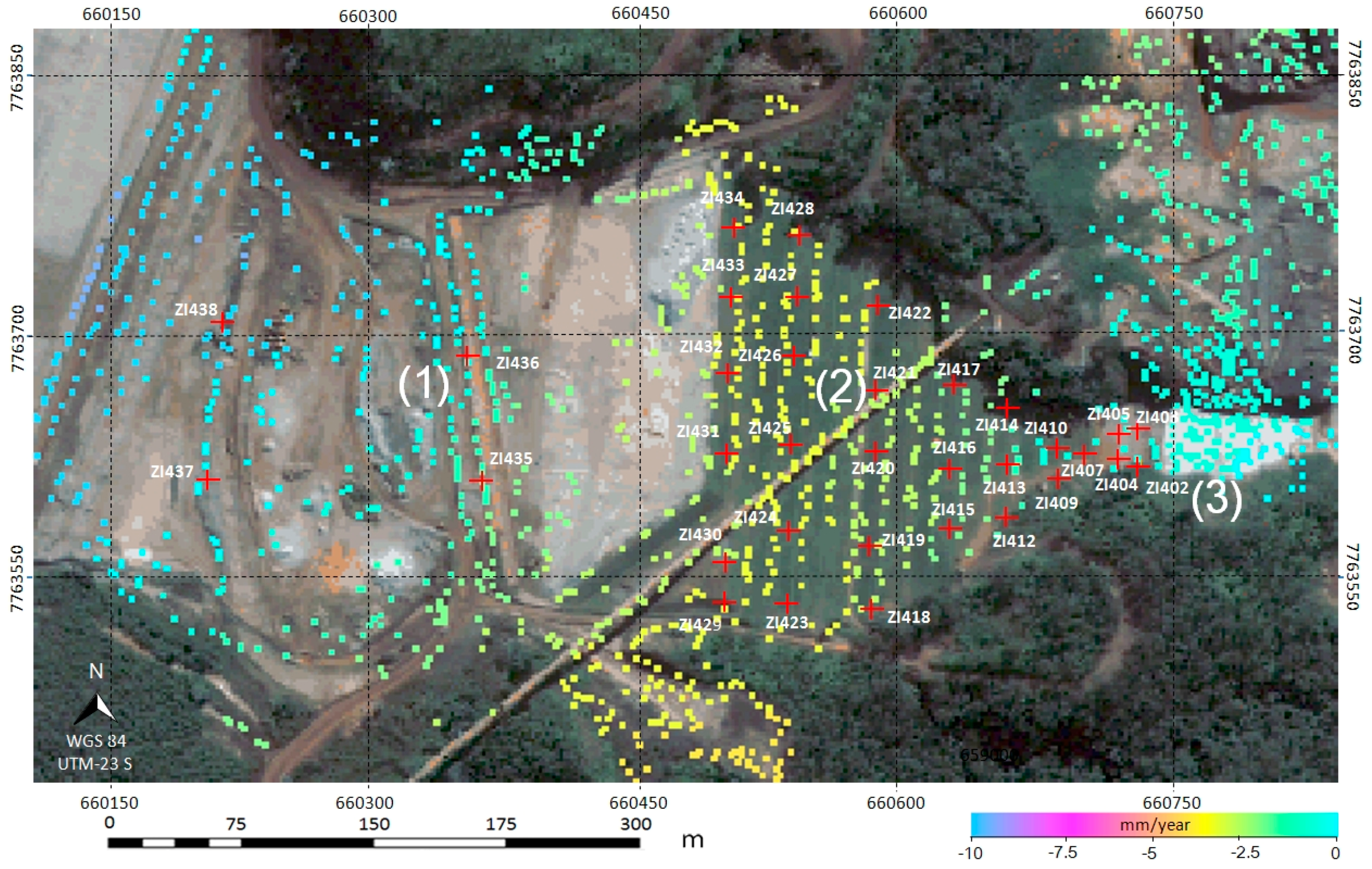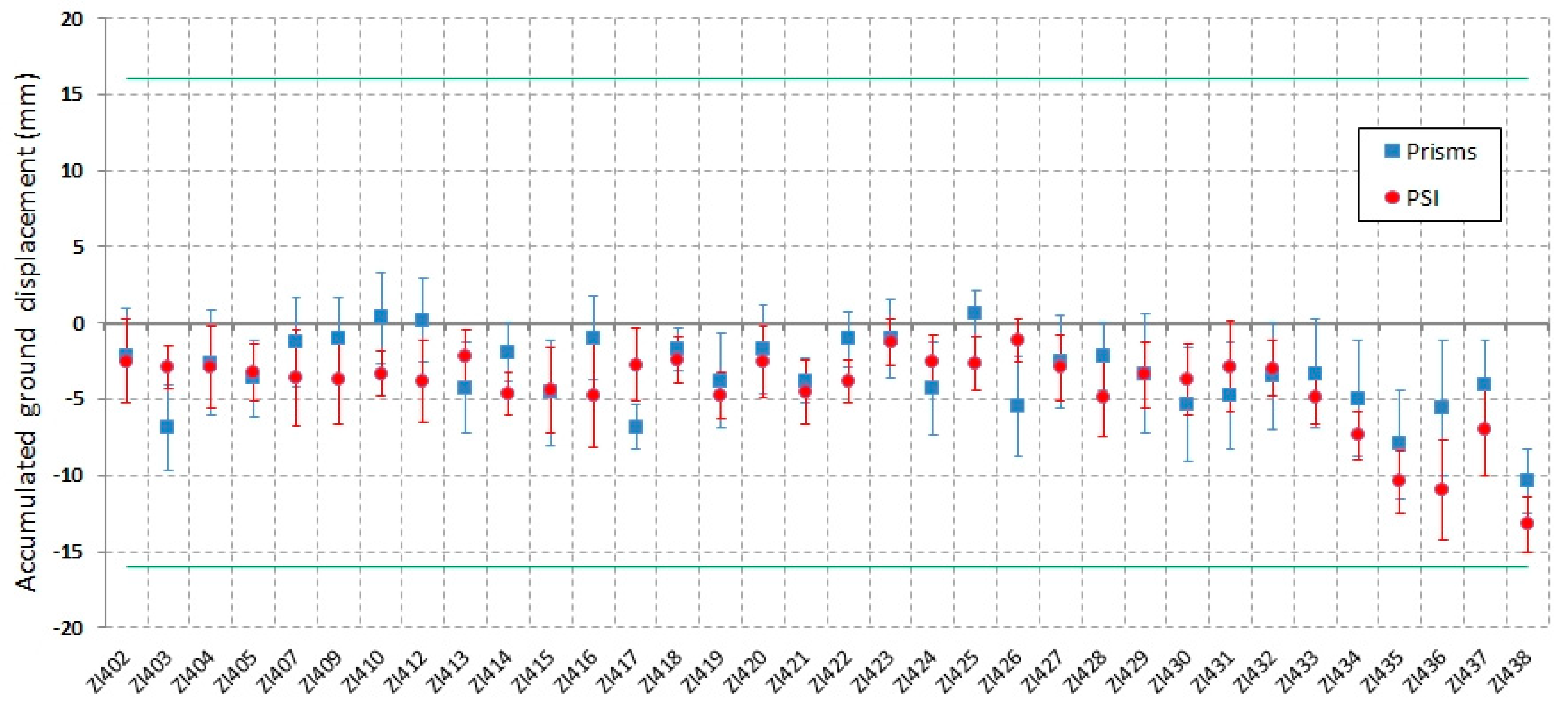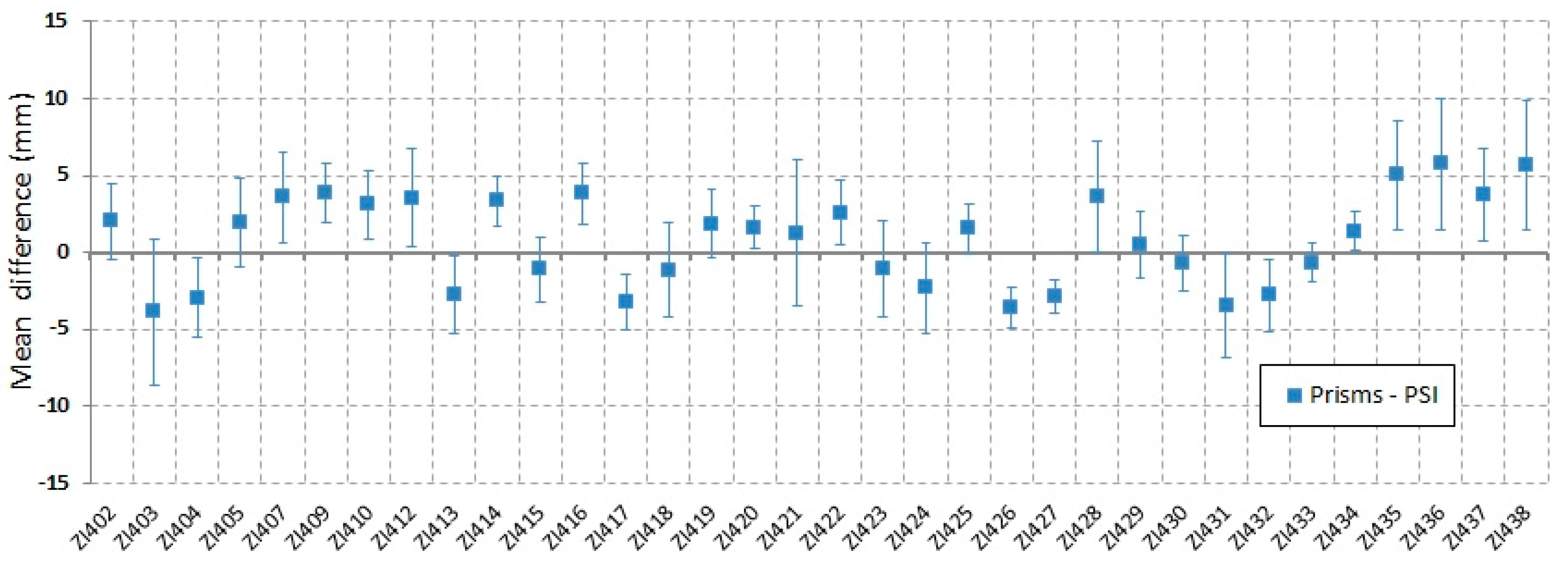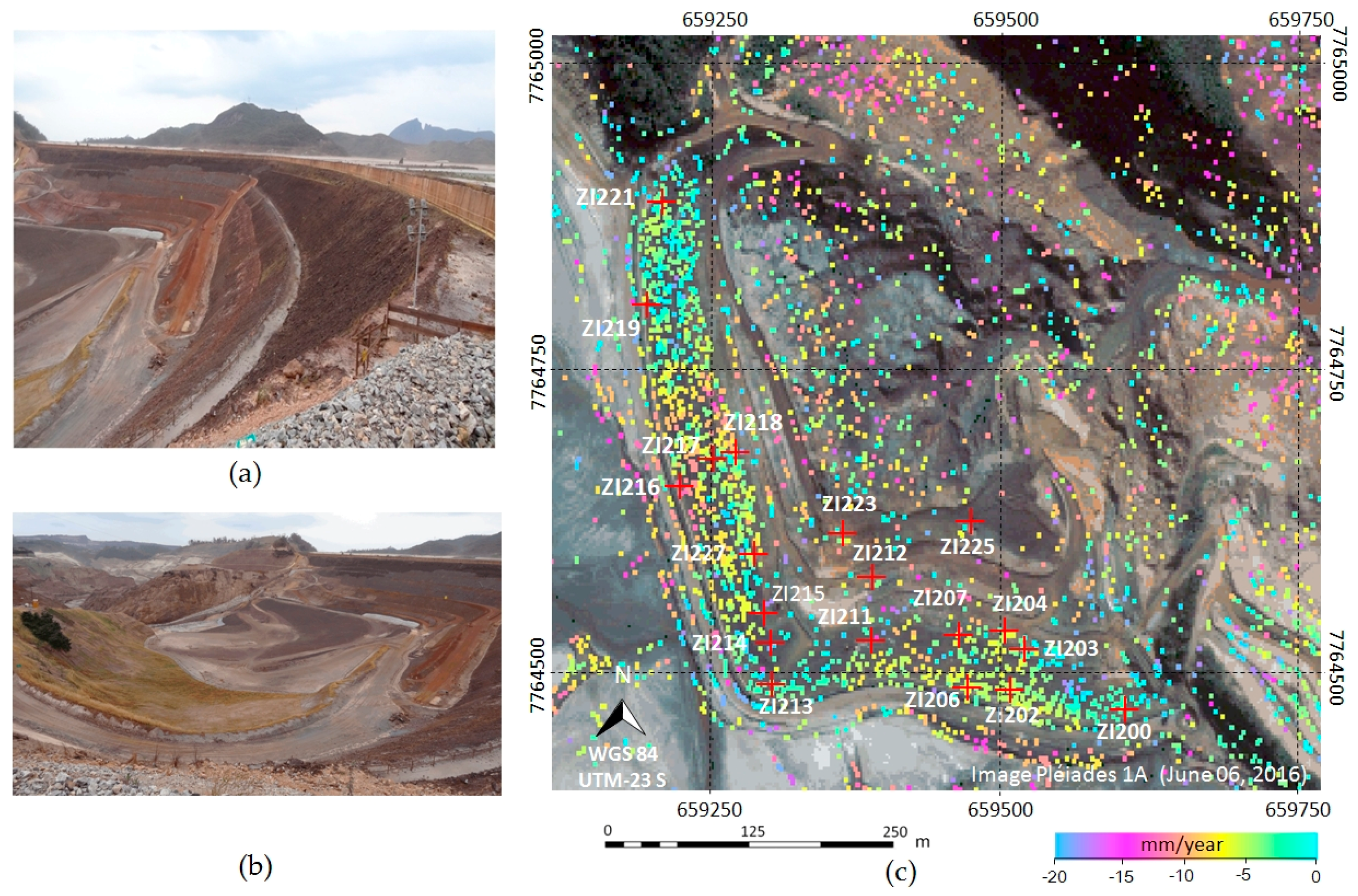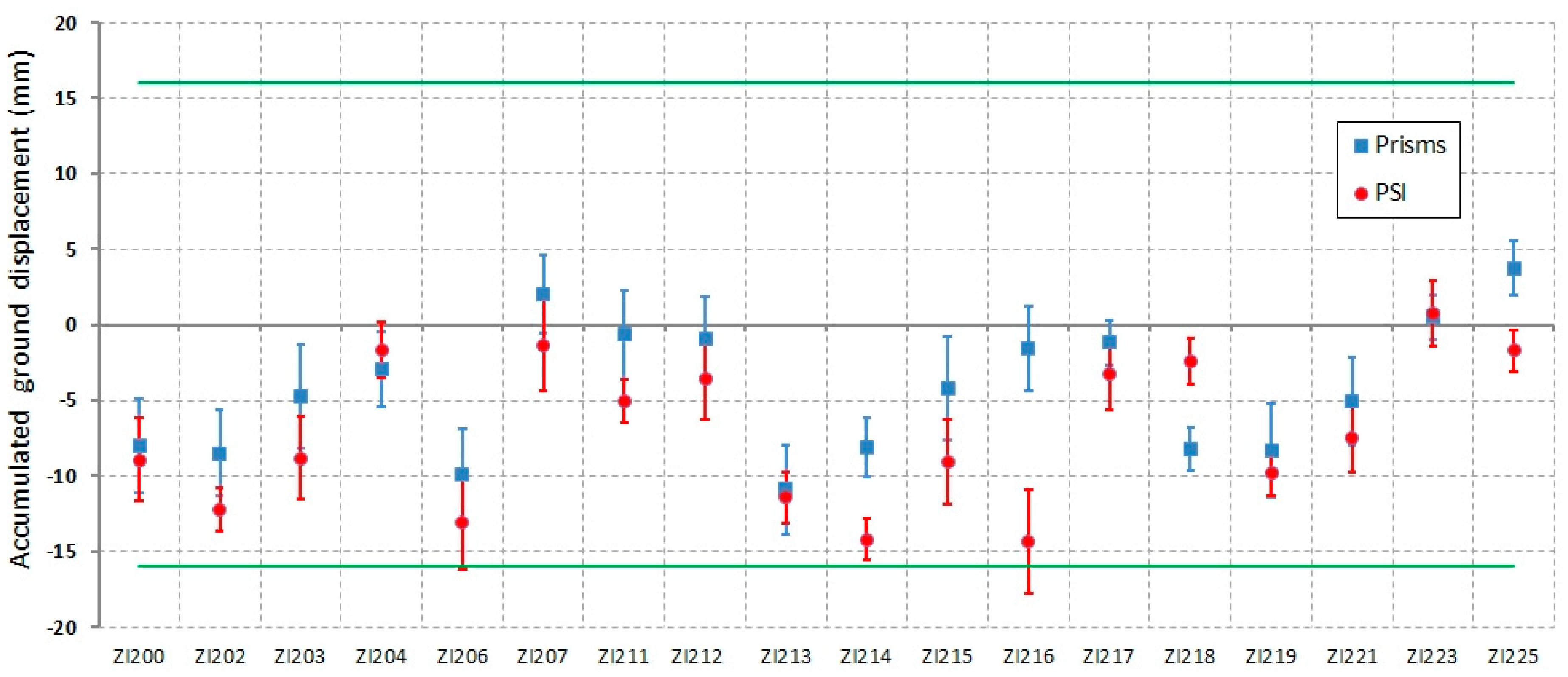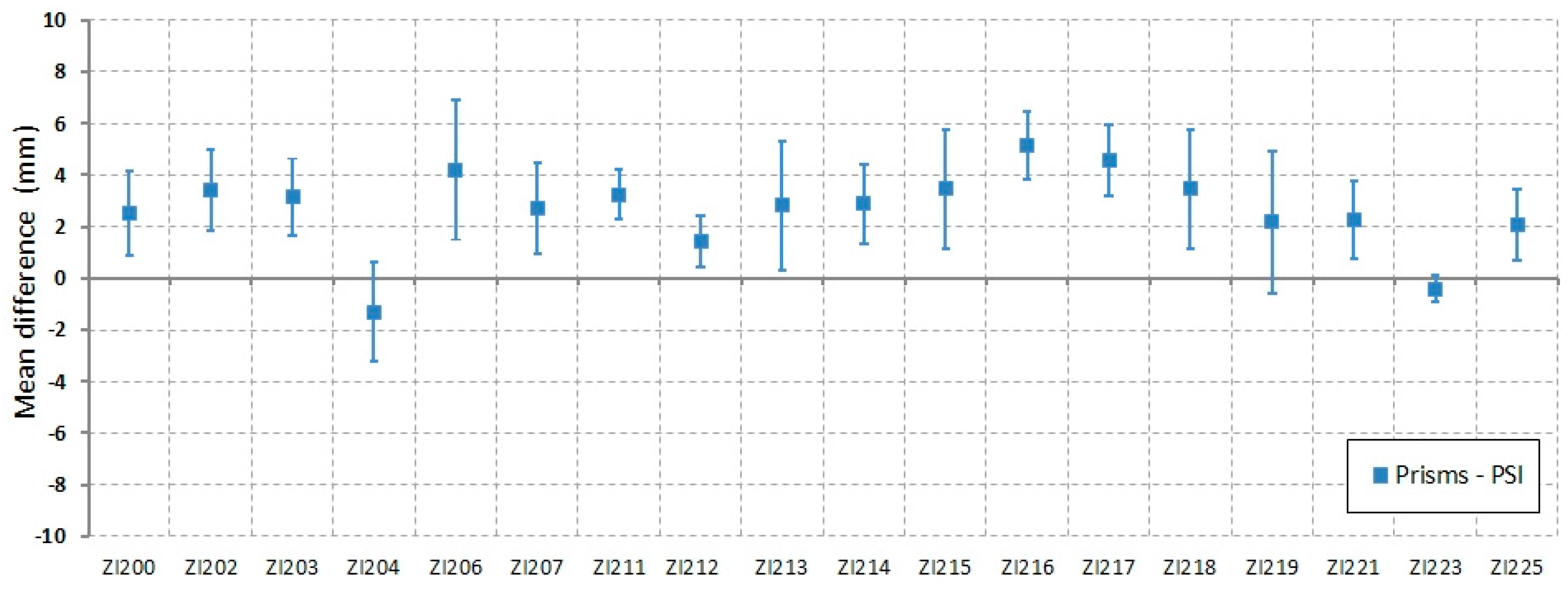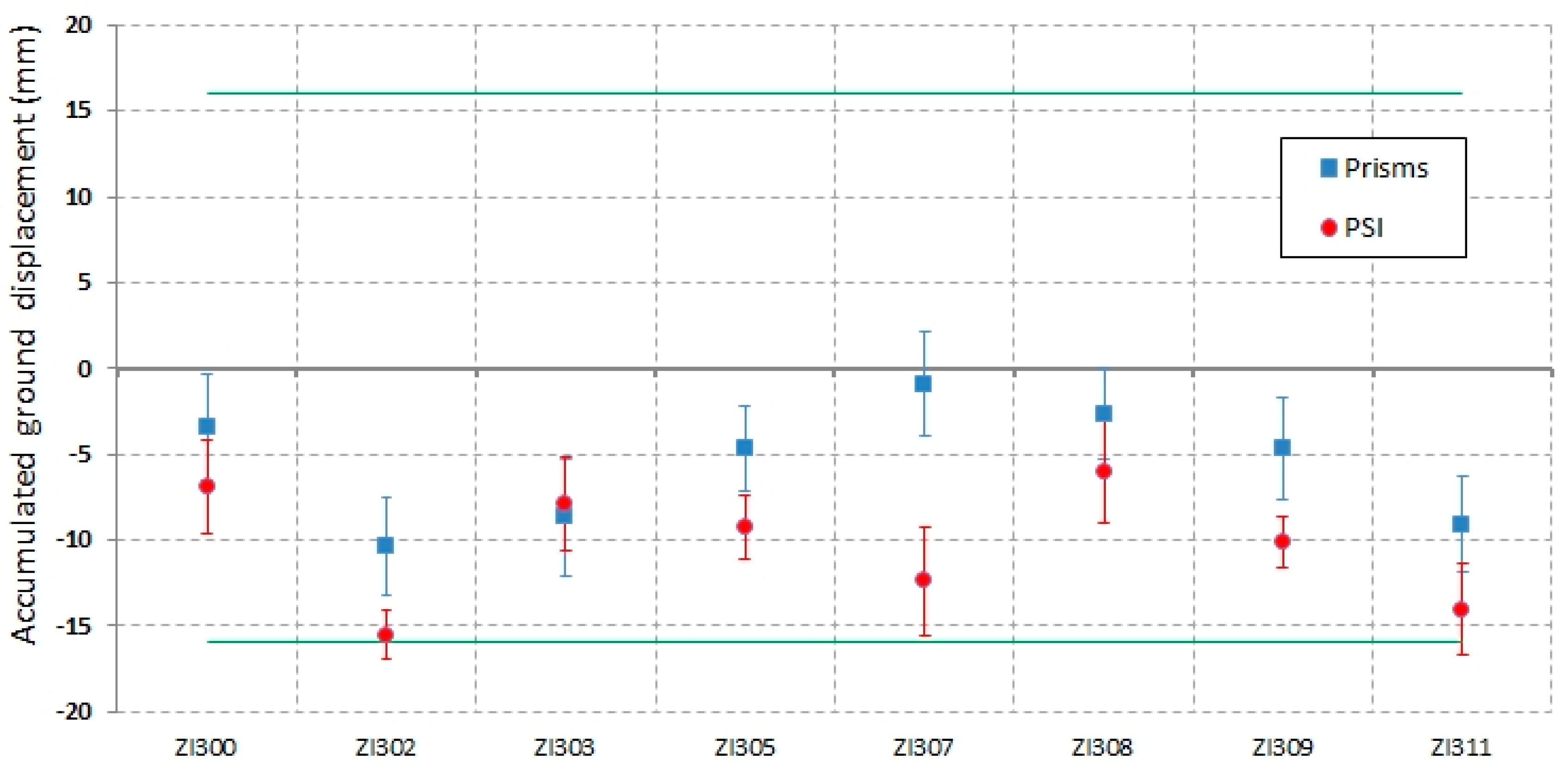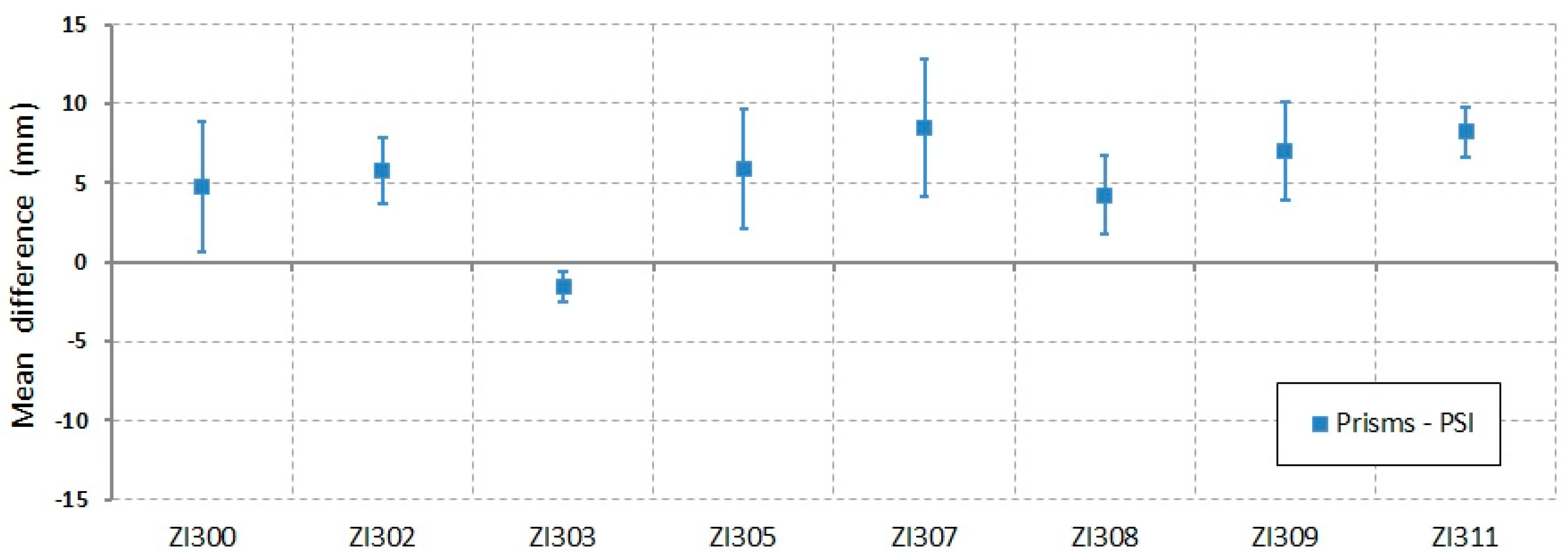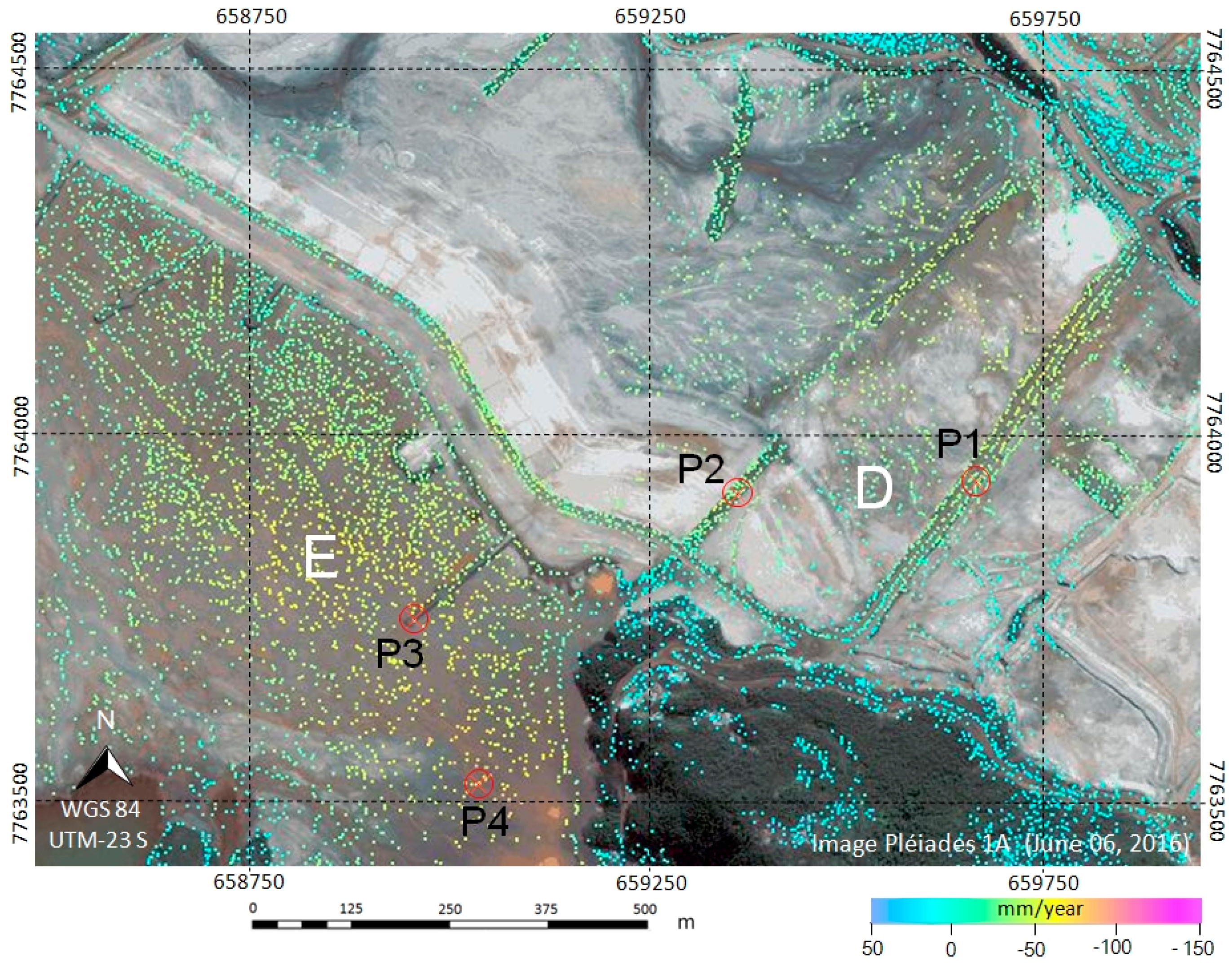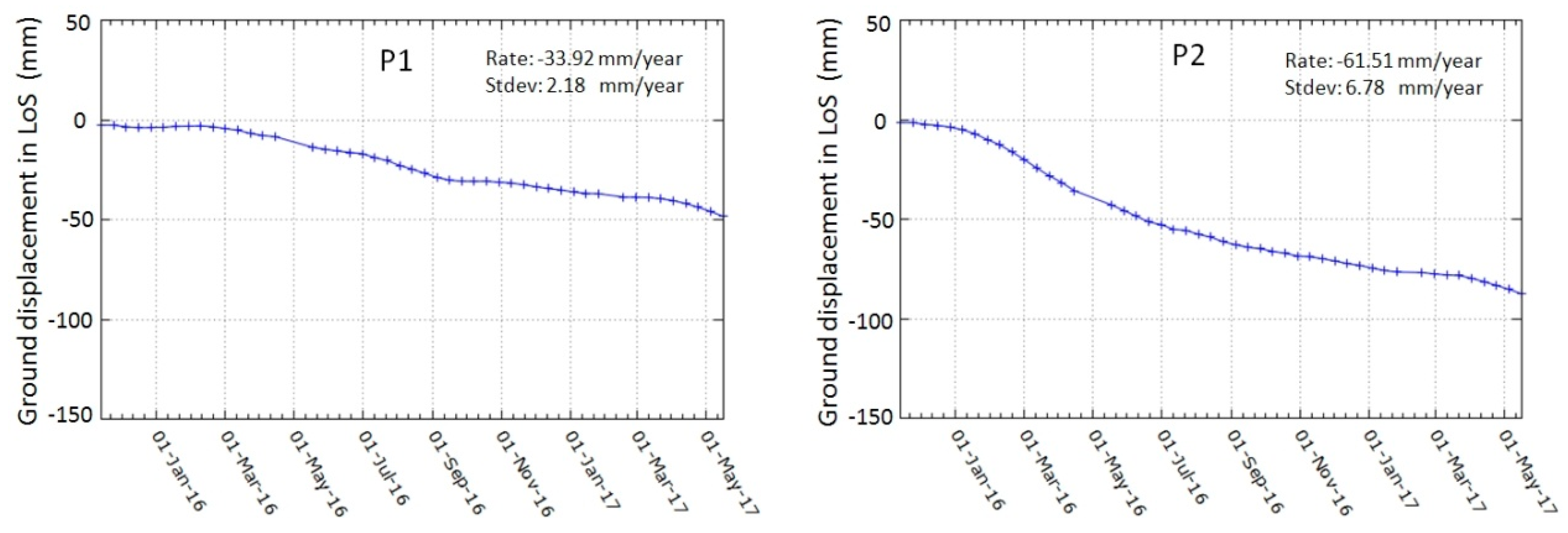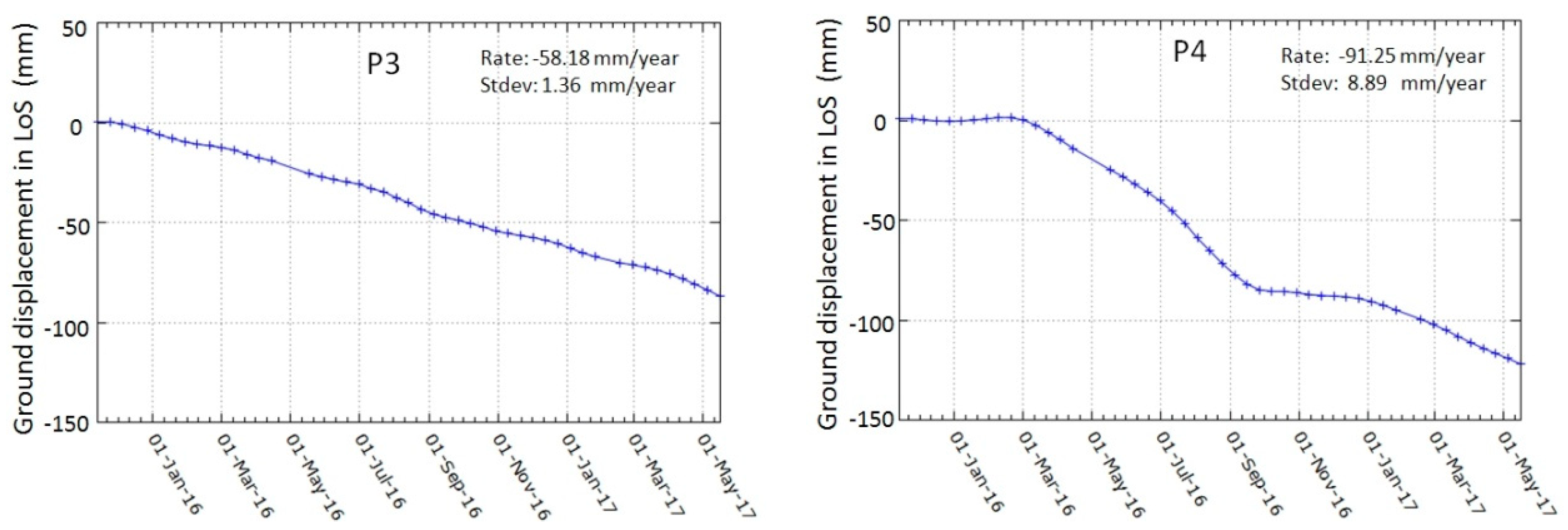1. Introduction
SAMARCO Mineração S.A., a 50-50 joint venture between the Brazilian Vale S.A. (the world´s largest iron producer) and the Australian-British BHP Billiton Brazil Ltd. (Melbourne, Australia), owns and operates the Germano iron mining complex, with an installed production of iron pellets of 30.5 million of metric tons, and iron waste of 20.7 million of metric tons in 2017 [
1]. The complex is located in the municipality of Mariana, Minas Gerais State, which accounted for 72.5% of the Brazilian iron reserves (19.4 billion of tons) and 68.8% of national production in 2013 [
2]. The Germano complex includes open pit mines, waste piles, industrial plants, pipelines, and a system of three dams, the Germano and Fundão tailings dams and the Santarem dam, a reservoir where water is stored for industrial reuse (
Figure 1).
The Fundão dam was one of the megastructures of the Germano complex, with dimensions of ~500 m length and main walls 110 m high. The structure was installed in 2008, with storage of 55 million cubic meters of tailings materials (November 2015). On the afternoon of 5 November 2015, the Fundão dam collapsed, and about 32.6 million of cubic meters of mining waste spilled from the dam, about 60% of its overall capacity at the time. The event produced mud waves 10 m high, destroying buildings and infrastructure in the rural districts of Bento Rodrigues, Paracatu de Baixo and Gesteira, killing 19 people, polluting 668 km of watercourses from the Doce River basin to the Atlantic Ocean, and involving the Brazilian Atlantic Forest (considered one of the world´s biodiversity hotspots), estuarine, coastal and marine environments [
3]. Some of the waste tailings released by the failure of the Fundão dam flowed over the Santarém dam, causing a partial erosion of the main body of the dam, and concomitant damage to the supporting structures of the Selinha and Sela & Tulipa dikes on the side walls of the Germano dam.
A technical final report of the disaster concluded that the collapse was due to liquefaction, i.e., when solid materials (sandy tailings) lose their mechanical resistance and present fluid behavior [
4]. A related aspect of the failure was the series of three small seismic shocks that occurred earlier. Three events were detected ~1.5 h prior to the dam collapse, presenting regional Richter magnitudes (mR) of between 1.4 and 2.6. Another small event was detected around the time of the accident; four more with mRs ranging between 1.3 and 1.9 occurred over the following days [
5]. The events are consistent with seismic intensities IV–V in the Modified Mercalli intensity scale (MM), suggesting occurences at very shallow depths (<5 km). Computer modeling showed that the earthquake events caused an additional increment of horizontal movement in the slimes that correspondingly affected the overlying sands. Although the movements were quite small and the associated uncertainties large, this additional movement is likely to have accelerated the failure process that was already well advanced [
4].
Figure 2 shows optical images acquired before and after the Fundão rupture.
Different procedures have been applied for stability monitoring of dams, namely geodetic methods (total station/prisms, levelling, photogrammetry, Global Navigation Satellite Systems) and non-geodetic methods (optical fibre sensors, piezometers, inclinometers, ground-based radar). Despite the reliability and accuracy of these methods, they can provide measurements only for specific points or sectors of the dam, where instrumentation has been placed; furthermore, monitoring can be time consuming, and requires fieldwork. Multi-temporal satellite SAR acquisitions have improved the capability of detecting temporal changes of deformation phenomena. Two classes of A-DInSAR (Advanced-Differential Interferometric Synthetic Aperture Radar) Time-Series analysis have been addressed to obtain ground-displacement information. A class based on a stack of multi-referenced differential interferograms, sensitive to stable and distributed scatterers, has been successfully used [
6,
7,
8,
9,
10]; this is known as the SBAS (Small Baseline Subset) technique. The second, based on a stack of master-referenced differential interferograms, relies on identifying pixels whose scattering properties do not vary much with time, also called persistent scatterer (PS) [
11,
12,
13], allowing a temporal analysis of the interferometric phase of individual point targets, as well as providing accurate information related to surface target displacements, called PSI (Persistent Scatterer Interferometry) technique.
A-DInSAR analysis has been used to measure ground displacement in underground mines [
14,
15,
16,
17,
18] and in open pit mines and related infrastructures [
19,
20,
21,
22,
23,
24,
25], due to its capabilities (i.e., synoptic coverage, reliable measurements of ground displacement, point-to-point accuracy at the mm scale, and dense grid sampling) and its ability to monitor large areas without the installation of equipment and field campaigns. The utilization of A-DInSAR for monitoring dam stability conditions is a recent trend, but it is not yet used on a regular basis, with few papers related to dam reservoirs [
26,
27] and tailings dams [
28]. Since the Germano dam encompasses a significant mining infrastructure with lateral supporting walls affected by the Fundão collapse, the use of A-DInSAR is justified, due to a critical demand of information regarding risk after the aforementioned tragic event. In this paper, we present a clear example of the potential of A-DInSAR for risk assessment of a tailings dam after one of the mining industry’s largest environmental disasters.
The investigation was based on a combination of A-DInSAR analysis using SBAS [
7] and PSI techniques [
11] with GAMMA’s Interferometric Point Target Analysis (IPTA) concept [
12], applied on a set of 48 TerraSAR-X (TSX-1) images, acquired in the period of 11 November 2015 and 15 May 2017, aiming at obtaining complementary information between coverage (SBAS) and resolution (PSI) of the ground displacements in the Germano tailings dam and associated structures. The results were compared with available in situ monitoring data, based on total station and mini reflective prisms.
Section 2 presents the study area,
Section 3 the materials and methods,
Section 4 the data processing,
Section 5 the results,
Section 6 the discussion and
Section 7 the conclusions.
4. Data Processing
Multi-referenced differential interferograms, with topographic phase components removed (simulated from a precise DEM) were generated from the stack of images. The combination of interferometric pairs to perform the time-series analysis was based on the concept of a small baselines subset (SBAS) [
7], where pairs of images were selected based on maximum values of time difference (temporal baseline) and distances (perpendicular baseline). In this work, a time interval of 42 days and normal baseline of 900 m were used, generating 118 interferograms, as shown in
Figure 4. The interferograms were spatially filtered (multi-look) using a 2 × 2 window size, which resulted in pixels size of 3.8 × 1.8 m (azimuth and slant range), with the purpose of reducing the phase noise component.
An adaptive spectral filter with a window size of 32 × 32 was applied to the interferograms to generate interferometric coherence images [
32]. Regions with coherence below 0.5 were masked out (especially in vegetated areas around the study area). The spatial phase unwrapping of the interferograms was carried out using the MCF (Minimum Cost Flow) algorithm [
33]. Visual inspection was also used to discard interferograms with compromising phase unwrapping errors.
For the inversion of the system of equations with the SBAS approach, a set of weighted constraints on the acceleration of the displacement was introduced to control the smoothness of the time-series solution [
8], thereby minimizing the atmospheric artifacts. The smoothing constraint parameter (with the value of 1.6) and the terms related to the derivative of the phase in relation to the height (proportional to the normal baseline) for topographic error estimation were incorporated into the system of equations, and the inversion was performed using an extension of the SVD [
34].
For the PSI analysis, a stack of 48 co-registered SLC images was used to generate the interferometric pairs in relation to a master image, acquired on 22 July 2016, whose selection was made based on low perpendicular baseline dispersion and its position nearly at the center of the time series, as shown in
Figure 5. A reference point was selected in a stable area, and the phase value of this point was subtracted (modulo-2π) from all PS phase values, creating a set of differential interferograms for each PS. As PSI analysis is related to the master image, the phase related to the ground displacement and topographic phase errors, previously found with SBAS solution, were spatially interpolated to full resolution, and then reorganized according to the master scheme (single reference), before subtraction in modulus 2π from the PS phase.
PSI analysis was performed using the IPTA module approach [
12], i.e., the approach implemented in GAMMA RS software. The topographic error was estimated based on a linear dependence of the topographic phase to the perpendicular baseline components, presenting diversity values from −173.16 up to 914.83 m for the 48 pairs, as shown in
Figure 5.
The PSI analysis was performed on the residual phase of each PS obtained after the subtraction of the phase displacement and topographic phase error, provided by SBAS analysis. The residual ground displacement was estimated through linear time dependence to the deformation, which was computed through a linear regression between time and phase variation for each PS, using limited deformation rates from −10 up to 10 mm/years. The phase standard deviation of the linear regression was predefined to 1.2 radians, which allowed detecting and rejecting points which were not suitable for PSI analysis. Atmospheric phase delay may account for most of the linear regression deviation (residues) related to the deformation, and its components were strongly attenuated by using a spatial filter of 500 × 500 samples, considering its characteristic, i.e., being spatially correlated and temporally uncorrelated. After removing the atmospheric phase (spatially-filtered residues) and noise phase (temporarily-filtered residues), the remaining phase accounts for the residual linear and nonlinear deformation phase. After a step-wise iteration, the outputs of the PSI analysis, ground displacement, and topographic errors were added to the interpolated SBAS results, providing the final ground displacement estimation and the final topographic error, pointing out that only the PSs that fulfilled the PSI processing constraint were added.
5. Results
The results of the SBAS based on the interferometric pairs configuration are shown in
Figure 4, providing information regarding the displacement velocity (
Figure 6) and the digital elevation error (
Figure 7). These results were used as preliminary information to perform the PSI analysis.
The results of PSI processing are presented in
Figure 8, showing the Sela & Tulipa dike (A), Selinha dike (B), and the main Germano dam and buttress area (C). In these structures, patterns of stability can be seen. In the auxiliary dikes used for the access of trucks and heavy equipment (D), and in the Baía 3 dam and reservoir (E), patterns of the ground displacement can be observed.
During the period of TSX-1 acquisitions (11 November 2015 to 15 May 2017) sectors of the Germano dam were monitored with a total robotic station covering several intermittent time intervals. We used the time intervals with topographic measurements to perform the comparison between in situ topographic measurements and PSI results; the longest period was from 9 August 2016 to 15 May 2017.
Topographic monitoring was performed with a Leica TM50 0.5″ (half second) robotic station, whose manufacturer-specified nominal accuracy is 0.6 mm + 1.0 ppm. The prisms used for monitoring were the 2” GPR112 (two seconds) model. Considering that the longest monitoring distance was 815 m, and the angular errors of the prisms and the station were 2.5” (two seconds and half), the monitoring error (ME) totaled ±10 mm (ten millimeters). Since, in theory, the zero reading can present the same nominal error, the limit of two times the nominal error (accumulated error totalizing 20 mm) was established as a safety limit for the detection of movements according to the geotechnical team of SAMARCO Company, and used for purposes of analysis of the results. Thus, values of vertical displacement projected in LoS (35° of incidence angle) within the interval of ±16 mm (bar error limits) were interpreted as accepted errors, while accumulated displacement outside this interval probably expresses real deformation.
The accuracy of the PSI results depends on many parameters, such as the number of SAR images, the spatial distribution of PS, climatic conditions, distance from the reference point, and the quality of PS within the area of interest. Typically, using datasets of more than 20–30 satellite images, errors on individual measurements are usually limited to within ±5 mm [
21].
Figure 9 shows field pictures of the main wall of the Germano dam divided into three sectors: the upper sector (a), steepest sector (b), and buttress sector (c).
Figure 10 shows the ground displacement map of each sector with the positions of the 34 prisms located along the wall.
The main wall region of the Germano dam did not suffer a direct impact of the rupture of the Fundão dam, like those suffered by the dikes of Sela & Tulipa and Selinha, whose mining waste material of Fundão reservoir made direct contact with these dikes.
Figure 10 shows the map of the ground displacement in three sectors of the main Germano dam: the upper sector (1), steepest sector (2), and buttress sector (3). Patterns of stability can be seen in these three sectors, with the sector (1) showing a very small displacement rate. The PSI results were compared with in situ topographic measurement with robotic station as shown in
Figure 11.
Figure 11 shows the box plot of the accumulated displacement (projected in LoS) and standard deviation for the 34 prisms monitored with robotic station during the period of 11 November 2015 to 15 May 2017 in the main Germano dam (
Figure 10). All prisms presented accumulated displacements within the error limit (±16 mm). PSI results also exhibited low accumulated displacements for the 34 PS analyzed (closed to the prisms positions), showing values also within error bar limits. The results shown in
Figure 11 indicate stability in the main Germano dam during the time interval of the analysis (11 November 2015 to 15 May 2017) according to the safety criterion used by the geotechnical team of the SAMARCO Company.
The points ZI435, ZI436, ZI437, and ZI438 with more pronounced accumulated displacement are located in the sector 1 (
Figure 10), corresponding to the dam sector constructed with a compact mixture of sand and silt-sized particles (
Figure 9a), that suffered an accommodation due to the traffic of heavy vehicles, and no deposition of material during the period of the analysis.
A box plot of the mean difference and standard deviations of the measurements (topographic minus PSI), performed during the period of 11 November, 2015 to 15 May 2017, is shown in
Figure 12. Some points (ZI403, ZI431, ZI435, ZI436, ZI437, and ZI438) presented significant discrepancy between the two methods. This could be explained by the intrinsic errors of the topographic data collection (including adverse weather conditions, dust and haze during dry and wet seasons impairing the visibility among station and prisms, distinct operator teams, etc.), the intrinsic errors of the PSI processing, as well as the PS positioning that does not exactly match the prisms (the PS selection was based on the nearest neighbor of the prism).
Figure 13 shows the Sela & Tulipa dike with details of the field pictures of the wall (upper picture), the empty Fundão reservoir (lower picture), and the ground displacement map of the dike and surrounding area, with 18 points of in situ topographic measurements.
Figure 14 shows a box plot of the accumulated displacement and standard deviations for the 18 points monitored with robotic station and the PSI results in Sela & Tulipa dike, performed during the period of 11 November 2015 to 15 May 2017. All prisms presented accumulated displacement within the error limit (±16 mm). PSI results also exhibited low accumulated displacements for the 18 PS analyzed (closed to the prisms positions), showing values also within the error limits.
Several points in the Sela & Tulipa dike (ZI200, ZI202, ZI206, ZI2013, ZI214, ZI215, ZI216, and ZI219) presented a more pronounced ground displacement for both measurements techniques, but were still within the error limits This could be explained by the fact that after the disaster, this dike was reinforced, and the material placed on it had been compacted during the period of the analysis. This fact did not compromise the stability of this structure, according to the geotechnical team of the SAMARCO Company (Mariana, Brazil).
A box plot of the mean difference and standard deviation of the measurements (topographic minus PSI) performed during the period of 11 November 2015 to 15 May 2017 is shown in
Figure 15 for the Sela & Tulipa dike. Some points (ZI206, ZI216 and ZI217) presented significant discrepancy in mean value difference between the two methods; a possible reason for this was already explained for the results presented the
Figure 12. It can be noticed in
Figure 15 that the mean values of the differences are slightly smaller than those shown in
Figure 12, probably due to the denser grid of PS in the wall of Sela & Tulipa dike, meaning smaller distances between prisms and PS positions.
The Selinha dike is shown in
Figure 16, with a field picture of the wall (a) and the ground displacement map of the dike and surrounding area, with the location of 8 points of field topographic measurements (b). The comparison between the topographic measurements and the PSI results are presented in
Figure 17.
Box plot of the mean difference and standard deviation of the measurements (topographic minus PSI) performed during the period of 11 November 2015 to 15 May 2017 is shown in
Figure 17 for Selinha dike. All prisms presented accumulated displacement within the error limits. PSI results also exhibited low accumulated displacement for the 8 PS analyzed (closed to the prisms positions), showing values within the error limits. The results shown in
Figure 17 are indicative of stability in the Selinha dike during the time interval of the analysis, according to the criterion of the error limit (±16 mm).
Several points in the Selinha dike (ZI302, ZI303, ZI305, ZI307, ZI309, and ZI311) presented a clear accumulated ground displacement. The causes of these behaviors can be explained due to the structural reinforcement works implemented in the dyke after the disaster, with material showing compaction during the period of the analysis. This fact did not modify the stability conditions of this structure, according to the geotechnical team of the SAMARCO Company.
The points ZI302, ZI307, and ZI311 presented accumulated ground displacement near to the error limit for the PSI analysis (
Figure 17), overestimating the ground displacement in relation to the prism measurements. It can be noted in
Figure 18 that the mean values of the differences are slightly greater than those presented in
Figure 12 and
Figure 15, probably due to the sparser grid of PS along the wall of Selinha dike.
The sectors D and E of the study area, as shown in
Figure 8, are related to auxiliary dikes and the reservoir. The dikes are supporting structures which serve to delimit the areas for tailings impoundment, allow proper handling material, and are also used as access routes. Since no deposition of material occurred after the Fundão rupture, the soils within the reservoir underwent an overall compaction (settlement). In addition, compaction also occurred along the auxiliary dikes due to continuous traffic of trucks and heavy equipment.
Figure 19 shows field pictures of the Baía 3 dam and its reservoir and the auxiliary dike that is used for trunk movements and monitoring.
Figure 20 shows the map of ground displacement in LoS of the sector D and E (
Figure 8) occurred during the period of 11 November 2015 up to 15 May 2017. Four points in this area, P1, P2, P3 (located on the auxiliary dike), and P4 (located in the Baía 3 reservoir) were selected for verification of displacements during the analysis period.
Graphs of the accumulated ground displacement are shown in
Figure 21 for the point P1 and P2, with accumulated values of −49.52 and −82.06 mm, respectively, and in
Figure 22 for the point P3 and P4, with accumulated values of −80.43 and −125.67 mm, respectively.
The criterion for the selection of the points P1, P2, and P3 was based only on their location on the auxiliary dikes, and on significant degree of subsidence. Point P4 was selected in a position within the reservoir of Baía 3 that presented a high degree of subsidence. Auxiliary dikes were built with a compact mixture of sand and silt-sized particles in roughly equal proportion, in order to withstand heavy vehicle traffic. The Baía 3 reservoir is composed by fine tailings (mud), being more affected by the terrain accommodation. Since no deposition of material occurred after the Fundão rupture, the soils underwent an overall compaction (settlement), affecting the auxiliary dikes and reservoir in different ways, depending on the material used in their creation. Points P1, P2, and P3 presented a quite linear behavior of deformation (
Figure 21 and
Figure 22), probably due to the same type of material used on auxiliary dikes constructions (
Figure 20), as opposed to the mud filled reservoir where P4 is located (
Figure 20) presenting a high nonlinear ground displacement (
Figure 22).
Figure 23 shows the ground displacement of the point P4 in the Baía 3 reservoir and its relationship with the annual average precipitation in Mariana-MG municipality [
35] during the period of the A-DInSAR analysis. It can be noted in
Figure 23 that the ground displacement increases during the dry season due to the process of the soil compaction (dry mud) within the Baía 3 reservoir, being less accentuated during the wet season.
6. Discussion
Over the last decades, DInSAR has proven to be an effective way for the detection and mapping of ground displacement in various fields of applications. This continuous growth can be related to (a) advances in the performance of satellite systems, providing data with improved temporal and spatial resolutions, (b) development made in data processing and analysis, including single interferogram methods and sophisticated implementations of A-DInSAR, such as PSI and SBAS, and (c) increases in computational capabilities with reduction of processing tasks.
Tailings dams are challenging to be monitored due to their size and sectors of inaccessibility. However, in order to keep functioning and to be considered structurally healthy need constant monitoring and assessing the deformation can be time consuming and economically costly.
Stability is basically measured with in-situ geotechnical instruments and visual inspections. However, with these conventional systems are not always possible to cover a vast area and information of displacements is limited to discrete number of survey points or sectors of the infrastructure. The overall agreement between remote and field information in our research means that A-DInSAR analysis is a reliable and powerful way to monitor stability evolution in time, compatible with in situ geotechnical information in this single site at risk. This geodetic technique represents a cost-effective way to monitor millimeter-level displacements (maximum measurement precision rate—lower than 1 mm, year single measure—lower than 5 mm) and can be used as supplemental analysis to detect movements in the tailings dam and its surroundings. Compared to conventional terrestrial methods of measurement (robotic station, ground-based radar) its advantages are: the time saved, the possibility to monitor a vast area with high density and without the need of any field visit or equipment installation.
However, the capability to measure fast deformation phenomena is limited due to the ambiguous nature of its observations, i.e., the wrapped interferometric phases. In fact, when the differential DInSAR displacement phase between two subsequent acquisitions is bigger than π, the actual deformation cannot be retrieved unambiguously. In order to get a correct estimation of the phase ambiguity, the phase gradient between close pixels has to be <π, this corresponds on the differential phases to a maximum differential deformation in LoS of the λ/4 (λ = 3.1 cm for TSX-1) in the revisit interval. It is important to note that the abovementioned condition concerns differential phases, i.e., phases computed over pairs of measured points. The actual capability to measure deformation over a given point depends on the spatial pattern of the specific deformation phenomenon in study; the smoother this pattern, the better capability; and the high point density over this phenomenon, the better capability [
36]. The limitation in detecting high rate of ground displacement can be addressed by reducing the temporal span between images. In the case of slow motion phenomena the main scope is the minimum detection limit. In these cases, multiple SAR images during long temporal periods can be acquired in order to get a redundant dataset of DInSAR observations. The advantage of adding redundancy is that atmospheric artifacts and noise from the phase signal can be cancelled.
In addition, the one-dimensional estimation of the movement in the LoS direction adds insensitivity to the N-S movements and limits the capacity of getting the entire frame of the ground motion. Results in our study, using solely the ascending mode, are highly sensitive to East oriented slope movements. However, incorporating multiple radar passes using different viewing geometries (ascending and descending orbits), the displacement vectors can be extended up to 3D.
Finally, despite of these advances with A-DInSAR, the cost of the commercial data has been a major obstacle for the operational used of the technology for this kind of purpose. With new data available based on constellation systems, with short revisiting time, almost daily coverage, and particularly systems providing free access data, such as Sentinel-1A and 1B, new possibilities are opened for the use of A-DInSAR for tailings dam monitoring. This will change the paradigm of static satellite analysis to the use aiming at near-real time monitoring.
